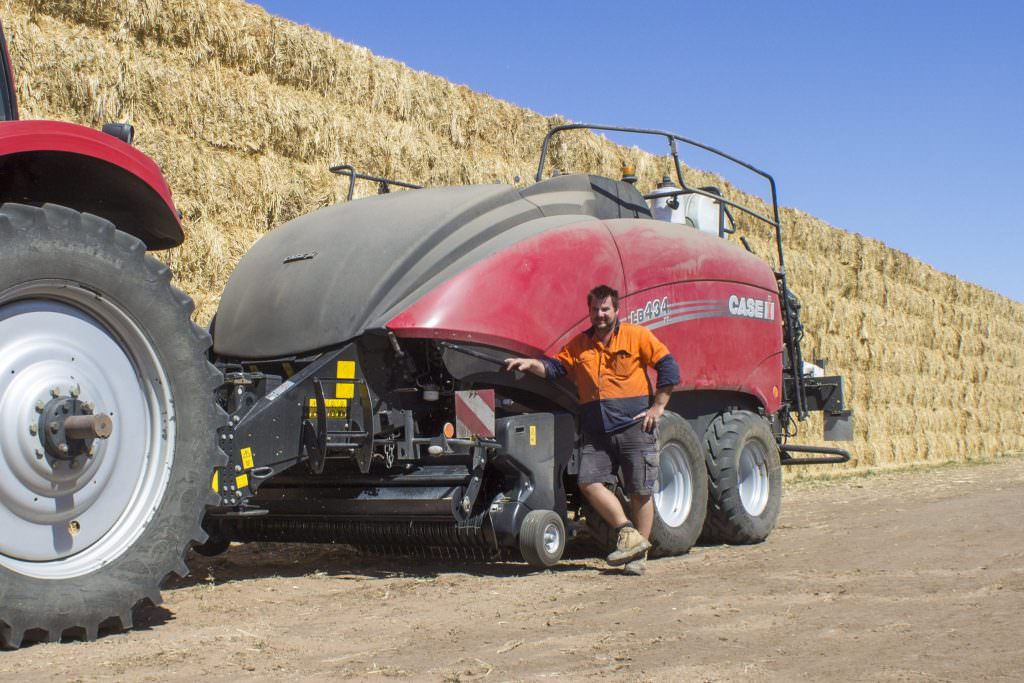
… a no-brainer for baler purchasing decision.
With five generations behind them, it’s a fair bet that the Somers family, who farm south of Warracknabeal, Victoria, have made some good decisions in their time. For Scott Somers, who’s currently at the helm, good decisions are often aided by good relationships. So when it came to choosing a new baler he turned to his trusted machinery supplier, Victorian Case IH Dealer O’Connors. The team recommended the Case IH LB434S XL, which was released into the Australian market in mid 2017. Having not used a Case IH baler before, Scott was keen to check it out.
“Eighty percent of our machinery is Case IH so it made sense to consider the Case IH Large Square Baler for compatibility, plus we have a great relationship with O’Connors,” said Scott, when explaining his decision-making process.
“They offered me a good deal and I knew I would be well supported from an aftersales perspective.”
Of course baler performance had to match the O’Connors service and there were no complaints from Scott. Hay is a big deal for the Somers’ family, making up approximately 30% of their 4000 hectare mixed farming operation. Scott’s summer program can include as many as 12,000 bales. Much of it is destined for the export market, so he was looking for a large square baler that could produce high density bales, without compromising on consistency, productivity and reliability.
“Early on, before we had rain on our hay, we were averaging around 750kg a bale,” said Scott, who pulled the baler with a Case IH 235 Magnum.
“After rain we came back to a more average program and saw bale weights between 670-700kg in oaten hay. It was up around 700kg in perfect conditions and back to 670kg as the day deteriorated. Achieving that was really good.”
According to O’Connors Warracknabeal’s Geoff Leith the greater weights and densities can be attributed to some new features introduced as part of the LB434S series.
“The bale chamber is now 31% longer, having been extended by 80cm. When you combine that with automatic feed rate control you can expect not just better bale shape and greater density, but also more consistent density across the day as conditions change,” explained Geoff.
For Scott, greater density directly impacts the bottom line via freight costs.
“By gaining weight in the bales and not changing the size I can ensure trucks are loaded to full weight, which helps us get our freight rate right,” he said, adding that he was also impressed with bale shape.
“We got very square corners so the truckies loved how the bales stacked and I also received multiple calls from end users to comment on how well the bales were presented. That’s the first time I’ve had that and it’s a nice feeling.”
Such a nice feeling, in fact, that Scott is looking to buy a second LB434S and, given the price point, thinks others should consider following suit.
“A lot of farmers might do 1000-2000 bales, with contractors doing their baling. At $18 a bale they’re looking at costs of between $20,000-$30,000. I think you’ll find that a farmer who does a bit more hay than the average Joe could buy this machine. It’s cost effective and gives them more control than using a contractor,” said Scott, who also runs his balers as a contractor, depending on his program.
“There comes a point in your farming life where you have to make a decision. Am I better owning a machine or using a contractor. It comes down to manpower and knowledge but I can certainly vouch that any machine bought from O’Connors will be well supported from a knowledge perspective.”
The Case IH LB434 XL series is available to producers in two models: the LB434S XL (Standard) and LB434R XL (Rotor Cut). Visitors to Wimmera Machinery Field Days in March 2018 can also see the LB434 XL series first hand and hear the latest from independent hay experts as part of daily panel sessions.
For more information contact your local O’Connors branch.

